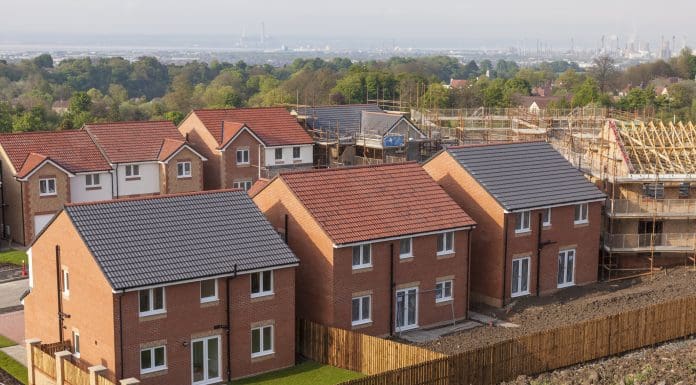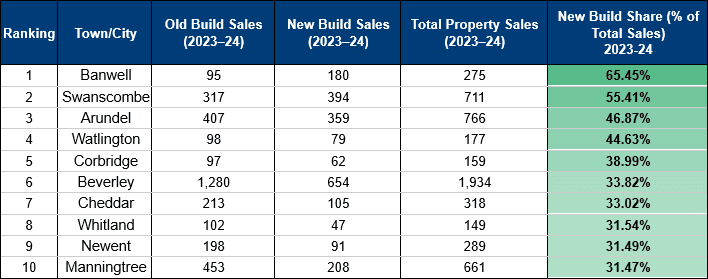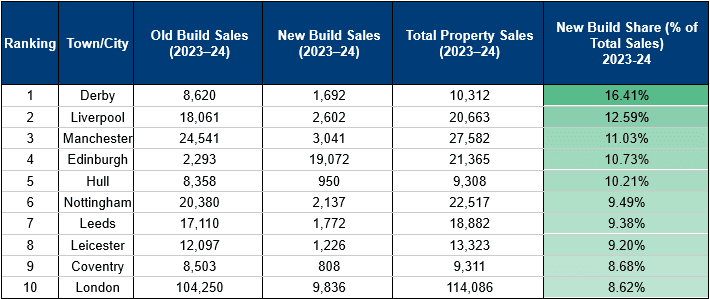
Data from the Alan Boswell Group reveals which towns in the UK are delivering the most new homes as the government targets require 340,000 per year
Smaller areas seem to be key deliverers for new-build houses, with Banwell, Swanscombe, and Arundel topping the leaderboard for new-build sales in 2023-2024.
Banwell sold 180 new-build homes in that time, making 65.45% of all property sales, while Swanscombe and Arundel held 55.41% and 46.87%, respectively.
Several different insights
The full table of the top 10 areas for new-build sales can be seen below:

The percentage of new-build houses sold in each area may be indicative of different issues. For example, Banwell is a small village in Kent, meaning the high rate of new-builds being sold could indicate rising demand for rural homes of similar quality to city homes.
However, Swanscombe is located relatively near to London, meaning demand for quality homes near the city is also rising.
At the other end of the scale, there are 207 towns and cities in the UK that had 0% of their home sales as new-build houses, including Twickenham in Greater London, Southsea in Portsmouth, and Hebden Bridge in West Yorkshire.
Most major cities also saw a low number of new-build sales, as can be seen below, indicating that the most populated areas may be falling behind in providing new homes.

Heath Alexander-Bew, on behalf of the Alan Boswell Group, said: “The UK’s housing demand remains intense, especially in large cities where new build construction often can’t keep up with population growth. However, this data clearly shows that regional development hotspots, even in smaller towns like Banwell or Swanscombe, are filling that gap.
“For buyers, especially families or first-time homeowners, these areas represent opportunities to secure modern, energy-efficient homes in growing communities. The proportion of buyers moving into detached homes has grown from 25% to 32% over the past decade, highlighting a steady shift in preference toward more spacious living. In our study, detached properties made up 13.87% of all new build sales between 2023 and 2025, underlining their continued appeal.”
A more nuanced issue
It should be noted that the data provided primarily examines the sale of new-build houses, which does not necessarily indicate the availability of new-builds or the number being built in those areas.
It should also be noted that the percentages should not be taken at face value, as the total number of houses sold in each area can skew them to seem more extreme.
For example, the 65.45% rate at Banwell applies to a total of 275 homes – 180 new builds, 95 old builds – while the 55.41% rate for Swanscombe applies to 711 homes – 394 new builds to 317 old builds.
This means that, while the rate of new builds sold in Banwell is higher by a little over 10%, the actual number of new build homes sold in Swanscombe is more than double that sold in Banwell.
Potential for new homes using empty buildings
Another report released earlier this month by Habitat for Humanity GB also highlighted the issue of empty buildings, which across the UK currently hold the potential for 25,000 homes to be retrofitted.
Henrietta Blackmore, national director of the Empty Homes Network for Habitat for Humanity Great Britain (HfHGB), said: “We know that empty buildings are only part of the answer to the housing crisis, but they should be an important part. Councils have full control over what they do with their assets, and must prioritise social homes.
“The budgetary pressures local authorities face are not helped by constant fire-fighting with scarce resources. Vulnerable people have better outcomes when they have access to safe, good quality accommodation. Providing that sort of housing now reduces the day-to-day costs that councils face tomorrow.
The post The UK’s new-build hotspots revealed appeared first on Planning, Building & Construction Today.

